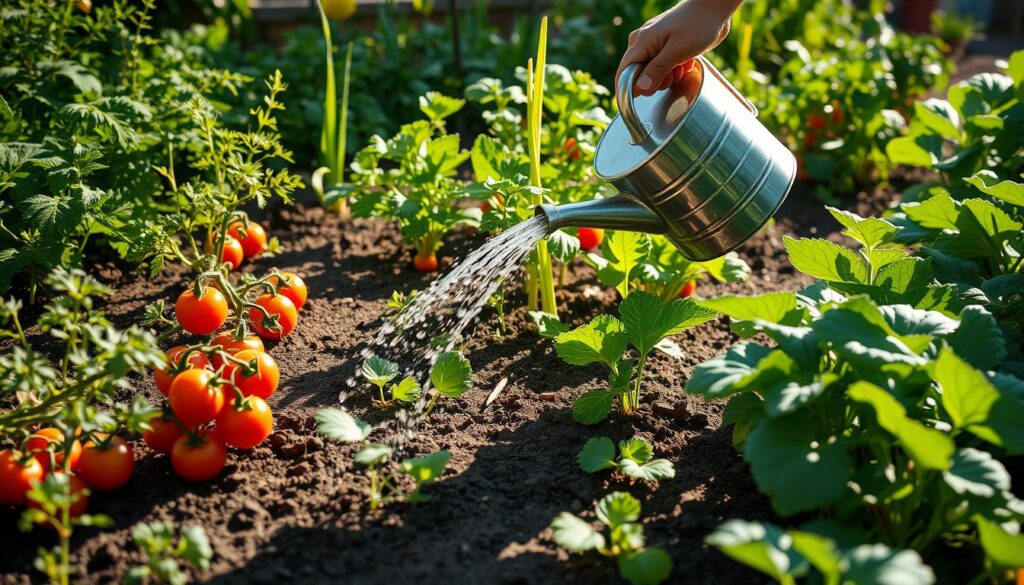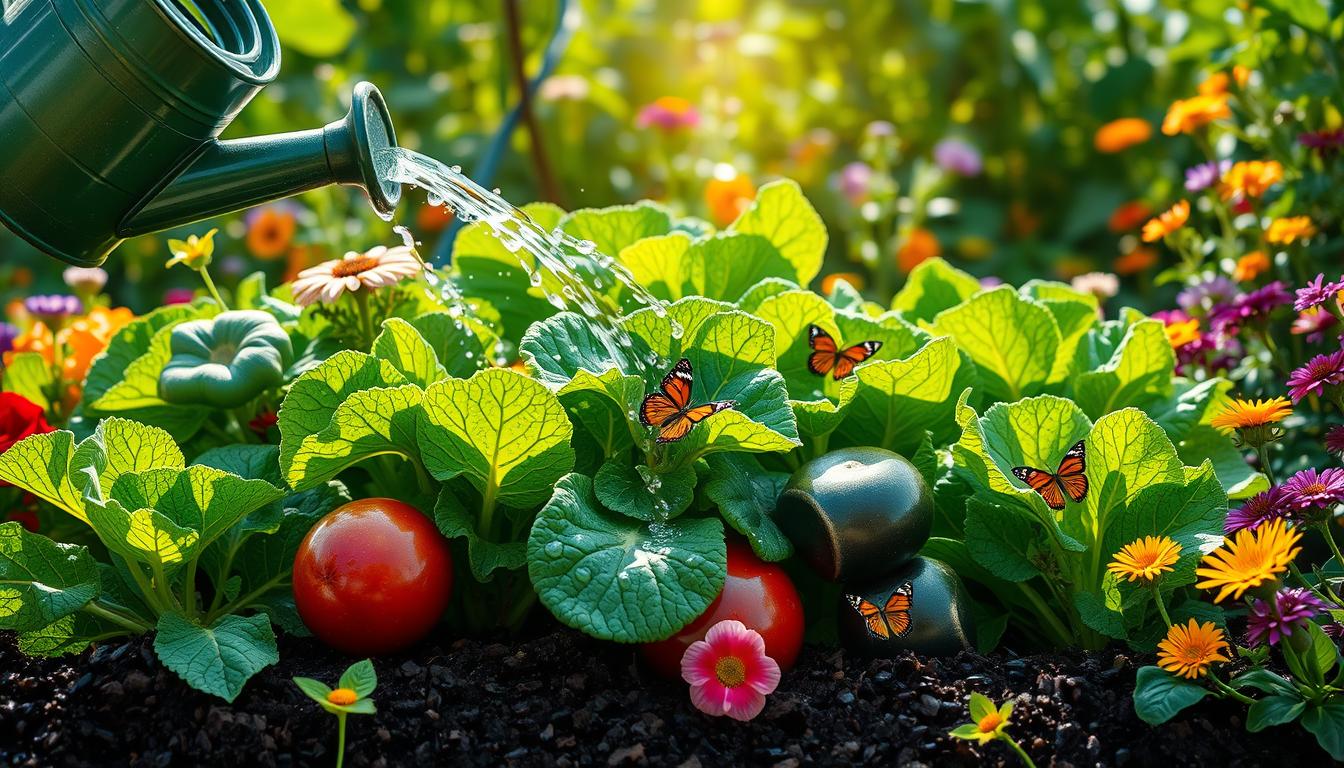As a passionate gardener, I know how important proper watering is. It makes your vegetable plants grow strong and healthy. In this article, I’ll share tips and techniques to help you water your vegetables right. Whether you’re experienced or new to gardening, these insights will help your garden flourish.
Key Takeaways
- Understand the factors that influence your vegetables’ watering needs
- Learn how to identify signs of over- and under-watering to maintain optimal moisture levels
- Discover the most efficient watering methods for your garden, from hand watering to automated irrigation systems
- Explore strategies for adjusting your watering schedule based on weather changes and climate conditions
- Implement water-saving techniques like mulching to promote sustainable gardening practices
Understanding Watering Needs for Healthy Vegetable Growth
Gardening is all about finding the right balance, and watering your veggies is key. The amount of water your plants need changes based on several things. These include the type of vegetable, the soil, the weather, and how old your plants are.
Factors Affecting Watering Requirements
Each vegetable has its own water needs. Leafy greens like lettuce need more water to stay green. On the other hand, root veggies like carrots need less.
The soil type also matters. Sandy soils dry out fast and need more water. Clay soils hold water better and need less.
The weather where you live is also important. Plants in hot, dry places need more water. Plants in cooler, wetter areas need less.
Young plants need more water than older ones. Seedlings and new growth need consistent moisture.
Signs of Over- and Under-Watering
Watching your plants closely can help you spot watering problems. If leaves are wilting or turning yellow, they might not have enough water. But, if the soil is always wet and plants have fungal diseases, you’re giving them too much water.
| Indicator | Over-Watering | Under-Watering |
|---|---|---|
| Leaves | Wilting, discolored, or yellowing | Wilting, curling, or drooping |
| Soil | Consistently wet or waterlogged | Dry, cracked, or hydrophobic |
| Plant Growth | Stunted, slow growth, or root rot | Stunted, slow growth, or wilting |
Knowing how to water your veggies right is crucial. By understanding what affects their water needs and watching for signs of too much or too little water, you can keep your plants healthy and productive.
Choosing the Right Watering Method for Your Garden
Choosing the right watering method is key for your veggies. You have many options, from hand watering to automated systems. I’ll guide you through the best vegetable garden watering methods for your garden.
Hand watering is a common choice. It lets you control water for each plant, perfect for small gardens. But, it’s time-consuming and not ideal for big gardens.
For bigger gardens, automated systems are a big help. Irrigation options like drip systems and sprinklers water plants automatically. They save time and ensure plants get the right moisture.
| Watering Method | Pros | Cons |
|---|---|---|
| Hand Watering |
|
|
| Automated Irrigation |
|
|
When picking a watering method, think about your garden’s size and plant needs. The right irrigation options ensure your veggies get the moisture they need. This way, they’ll grow well all season.
Mastering the Art of Hand Watering
Hand watering is a great way to care for your vegetable garden. It lets you give your plants the right amount of water. This way, you avoid wasting water and prevent overwatering.
When and How Often to Water by Hand
How often you water your veggies depends on a few things. These include the plant’s needs, the soil type, and the weather. Most plants need water often, especially when they’re growing fast.
Water your plants by hand once or twice a week. You might need to change this based on the weather.
Techniques for Efficient Hand Watering
- Use a watering can or a gentle garden hose spray to apply water directly to the soil around the base of the plants, avoiding wetting the leaves.
- Slowly and methodically water each plant, ensuring the soil is thoroughly saturated without creating puddles or run-off.
- Focus on the root zone of the plants, directing the water to the soil where it’s most needed.
- Pay attention to the signs of under- or over-watering, adjusting your hand watering technique accordingly.

Learning to hand water your veggies is key to a healthy garden. It helps your plants grow well and saves water. Remember, consistent and efficient watering is crucial for a thriving garden.
Setting Up an Irrigation System for Convenience
Looking to make watering your vegetable garden easier? An irrigation system can change the game. These systems keep your plants moist and save you work. There are many vegetable garden irrigation systems to pick from.
Types of Irrigation Systems for Vegetable Gardens
Drip irrigation is a favorite. It waters plants right at the roots, cutting down on evaporation. This means your plants get the water they need without wasting any.
Sprinkler systems cover more ground. They water your garden evenly. These automated watering options can be set to water at the best times, so you don’t have to.
Micro-irrigation is great for small spaces or limited water. It waters specific plants or rows. This is perfect for raised beds or tiny gardens.
Choosing the right system is important. Proper setup and care are crucial for it to work well. By picking the right vegetable garden irrigation systems, you’ll save time and keep your plants healthy.
“An efficient irrigation system can make all the difference in the success of your vegetable garden, saving you time and ensuring your plants thrive.”
How to Water Vegetables Properly: Tips for Healthy Plants
Watering your vegetables right is key to a healthy garden. Knowing the best ways to water helps your plants grow strong and gives you a big harvest. Here are the top tips for watering your veggies well.
First, figure out how deep and often to water. Water deeply and consistently to avoid drought stress and strong roots. Water your veggies 6-8 inches deep, letting the soil dry a bit before watering again.
Watering at the right time is also crucial. Water in the early morning or late afternoon to reduce evaporation. This ensures your plants stay moist during their growth periods. Don’t water in the hottest part of the day to prevent water loss and leaf scorch.
- Water deeply but less often to avoid shallow watering.
- Water in the early morning or late afternoon to reduce evaporation.
- Adjust your watering schedule based on weather and plant needs.
By using these watering tips, you’ll create a great environment for your plants. The goal is to give enough water without overdoing it. Too much water can cause root rot and disease. With practice, you’ll have a lush, healthy garden full of veggies.
“The secret to a thriving vegetable garden is to give your plants the right amount of water at the right time.”
Learning to water your veggies right is a must for gardeners. By following these tips, you’ll enjoy a rich harvest and a beautiful garden.
Adjusting Watering Schedules for Weather Changes
Keeping your vegetable garden healthy means being flexible, especially with watering. When it gets hotter and drier, watch your plants closely. Adjust your watering to keep them growing well.
Watering During Hot and Dry Conditions
In hot and dry weather, your plants need more water. This prevents them from wilting and growing poorly. Here are some tips to keep your garden watered:
- Water your plants every 2-3 days instead of every 5-7 days.
- Water in the early morning or evening when it’s cooler to save water.
- Water at the roots with drip irrigation or deep watering to avoid waste.
- Use mulch to keep the soil moist and save water.
By changing your watering schedule for the weather, your plants will do better, even when it’s hot and dry.
| Watering Frequency | Normal Conditions | Hot and Dry Conditions |
|---|---|---|
| Frequency | Every 5-7 days | Every 2-3 days |
| Time of Day | Any time | Early morning or late evening |
| Watering Technique | Overhead sprinklers | Drip irrigation or deep watering |
| Mulch | Optional | Recommended |
Adjusting your watering to fit the weather helps your plants stay healthy. This is especially true during the hottest and driest times.
Mulching: A Water-Saving Strategy for Your Garden
Mulching is a smart, green way to save water and keep soil moist in your veggie garden. It involves covering the soil with organic material. This helps your plants stay healthy without needing as much water.
Mulching stops water from evaporating. It acts like a shield, keeping the soil cool and moist. This means you water your garden less often. You save time, effort, and water this way.
Choosing the right mulch is key. Organic mulches like wood chips, shredded bark, or straw are great. They save water and add nutrients to the soil as they break down. Inorganic mulches, like gravel or rubber, work too, but they don’t help the soil as much.
To mulch right, first remove weeds and debris. Then, spread 2-4 inches of mulch, leaving space around plant stems to avoid rot. Add more mulch as needed to keep the right depth.
Mulching is a simple yet effective way to cut down on water use and grow healthier veggies. It’s a must-have for any eco-friendly gardener.
Water Conservation Tips for Sustainable Gardening
As a gardener who loves water-smart gardening, I’m thrilled to share some tips. These tips will help you save water and garden sustainably. By using these techniques, you can lessen your environmental footprint and grow a strong, healthy vegetable garden.
One simple way to save water in your sustainable vegetable garden is to harvest rainwater. Use rain barrels or cisterns to collect and store rainwater. Then, use this water to water your plants when it’s dry. This method greatly cuts down on your need for city or well water, making your gardening greener.
Another key technique is to pick water-smart gardening plants that fit your local climate. Choose vegetables and plants that don’t need much water. By picking the right plants, you can make a garden that needs less watering.
- Add organic matter, like compost, to your soil to help it hold water better and drain well.
- Put a thick layer of mulch around your plants to stop water from evaporating and keep the soil moist longer.
- Water deeply but not often, which helps plants grow strong roots and need less water.
By using these water conservation techniques, you can have a lush, sustainable vegetable garden. Plus, you’ll be helping to save this vital resource. Every bit of water you save helps make your garden more eco-friendly and water-smart.
“Gardening is the art of manipulating nature to produce a desired effect. Water-wise gardening takes this art to the next level, creating beauty and abundance while respecting our planet’s finite resources.”
Troubleshooting Common Watering Problems
Getting the right amount of water for your vegetable garden is key. But, it’s not always simple. Too little or too much water can cause problems like fungal diseases and nutrient shortages. Here, I’ll show you how to spot and fix these issues, so your garden can flourish again.
Addressing Fungal Diseases
Fungal diseases often come from too much water. This creates a damp, humid environment where fungi grow well. This can lead to powdery mildew, root rot, and gray mold. To fight these fungal diseases, first find out why you’re getting too much water and change your watering habits.
- Make sure the soil drains well to avoid being too wet
- Water plants at the base to keep leaves dry
- Improve air flow around plants to help them dry faster
- Use fungicides if needed to stop disease spread
Tackling Nutrient Deficiencies
Not enough water can also cause nutrient deficiencies in plants. Dry soil makes it hard for plants to get the nutrients they need. This can make plants grow slowly, turn yellow, and show other signs of nutrient imbalance. To fix these watering issues, try these steps:
- Change your watering schedule to keep the soil moist
- Use a balanced, water-soluble fertilizer to help nutrients
- Add organic matter to the soil to hold moisture and nutrients better
By finding and fixing the watering problems, you can solve many issues in your vegetable garden.

“The key to a healthy, thriving vegetable garden lies in mastering the art of proper watering.”
Conclusion
Proper watering is key for a healthy vegetable garden. It helps your plants grow well and gives you lots of food. We’ve covered how to water your garden right, from knowing what affects it to using irrigation systems.
By following these summary of vegetable watering tips, you’ll grow a healthy vegetable garden. It will be full of tasty and healthy food. Whether you’re new to gardening or have been doing it for years, paying attention to your plants’ needs is important. It will help you get great harvests and enjoy gardening more.
Try out these tips and see your plants grow strong and healthy. Enjoy the joy of gardening!



Leave a Reply